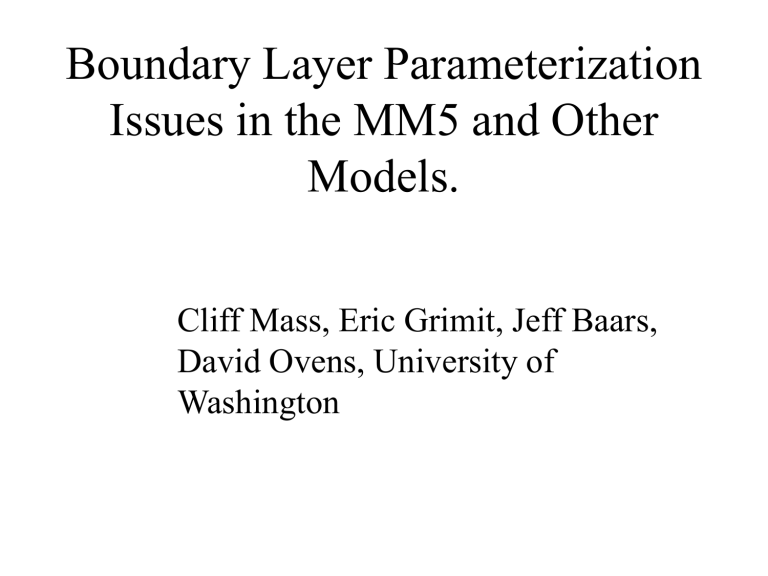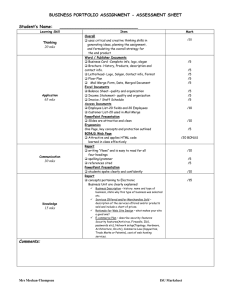Boundary Layer Parameterization Issues in the MM5 and Other Models.

Boundary Layer Parameterization
Issues in the MM5 and Other
Models.
Cliff Mass, Eric Grimit, Jeff Baars,
David Ovens, University of
Washington
Apparent Problems
During the past years a number of issues have become evident with the MM5 (and other) boundary layers, with the unproven implication that the PBL schemes or land surface schemes are to blame.
Basic Infrastructure
• MM5 36, 12, and 4-km real-time runs over the Northwest
• UW data collection effort (roughly 24networks over the region)
• UW Verification System
Some Observations
• 10-m Winds are too geostrophic.
• Positive wind biases (~2-3 knots) exist when all wind speeds are considered and turn negative for winds greater than three knots.
• Difficult to maintain shallow pools of cold air or shallow cloud layers.
Domain-Wide Biases
24h Forecast, Valid 12Z, all wind speeds-Night
12-h Forecast, Valid 00 UTC-DAY
Less Positive Bias at 00 UTC than 12 UTC
Questions
• Does this error vary with wind speed?
• Might part of it derive from wind sensor errors at slow speeds?
Instrument
Met One 014A
Met One 034B
RM Young 05103
RM Young 05106 "Marine" start threshold spd start threshold dir
1.0 mph - mph
0.9
0.9
2.2
RM Young 03001 "air quality"
RM Young 03101 "air quality"
Climatronics CS800
ASOS's F420 (company: n/a)
Vaisala WM30
Vaisala WA15/WA25
2.2
1.1
1.1
<1.0
2.3
<0.9
<1.1
2.4
2.4
1.8
1.8
<1.0
2.3
2.2
0.9
Looks like many networks are using the RM Young 05103. Agrimet does, the fixed/drifting buoy data does along with Vaisala,
Schoolnet and RAWS show a picture of one on their website although
Schoolnet mentions that stations installed prior to 1997 used a white cup/vane type.
Wind Direction
• Winds generally too geostrophic by 5-10 degrees
Looks Worse for higher wind speeds… 4km is best
But things changed this year
• Winds speeds developed a significant negative bias.
• We changed the source of surface verification data…from using the lowest sigma and surface data to using the PBL scheme output directly.
Wind Speed Bias Valid at 12 UTC for 24 h Forecast
Less Change at 00UTC-- still generally underforecast.
Wind Direction…00UTC
12 UTC
4-km MM5 is best by far!
Temperature Biases
• Large temperature biases can occur at certain times:
• When there is a shallow layer of cold air
(few hundred m deep) that is mixed out.
• During transition season (particularly spring, when land surface conditions are problematic)
• During summer during warm periods.
00 UTC
12 UTC
Problems with Shallow Cold Air
2-4 inches
January 6,
2004
Well-Forecast Snow Event
…but not the
Several days of freezing rain coasted Portland in a sheath of ice….PDX closed for THREE days
Shallow Fog…Nov 19, 2005
• Held in at low levels for days
• MM5 held in the inversion…generally without the shallow mixed layer of cold air a few hundred m deep
• MM5 could not maintain the moisture at low levels
Where are the problems?
• PBL parameterizations?
• Land surface models or surface specifications?
• Dynamical models themselves (too much diffusion, etc)?
• What happens at 1-10 km resolution when some
PBL structures are beginning to be resolved?
• Lack of verification/evaluation data/
Who is working on PBL parameterizations and evaluating current ones?
• Generally a hollowing out of the U.S. efforts (e.g.,
UW Energy Transfer Group)
• For MM5/WRF mainly Korean effort (Yonsei
University)
• Still activity in Europe…mainly Dutch?
• Some interest in UW; Forest Service sponsored effort, Chris’s group.
• No one at NCEP actively working on PBL parameterizations for mesoscale models.
Computer forecast models were nearly perfect for the onset and amount of snow over Puget Sound.
The End
They did not do a good job for the freezing rain over the east side and around Portland…. and we know why.

